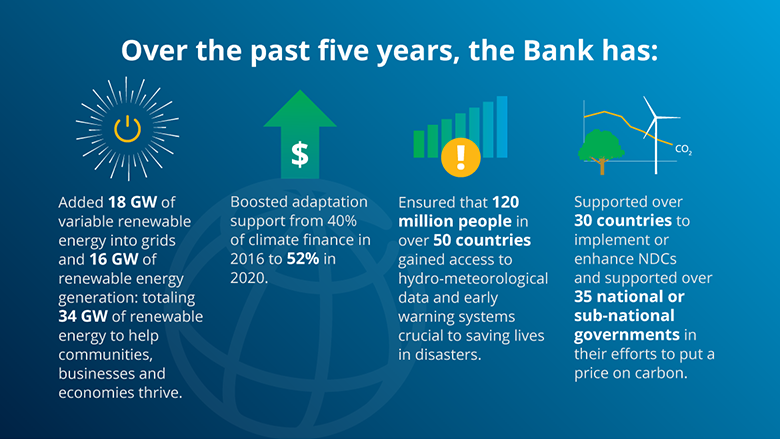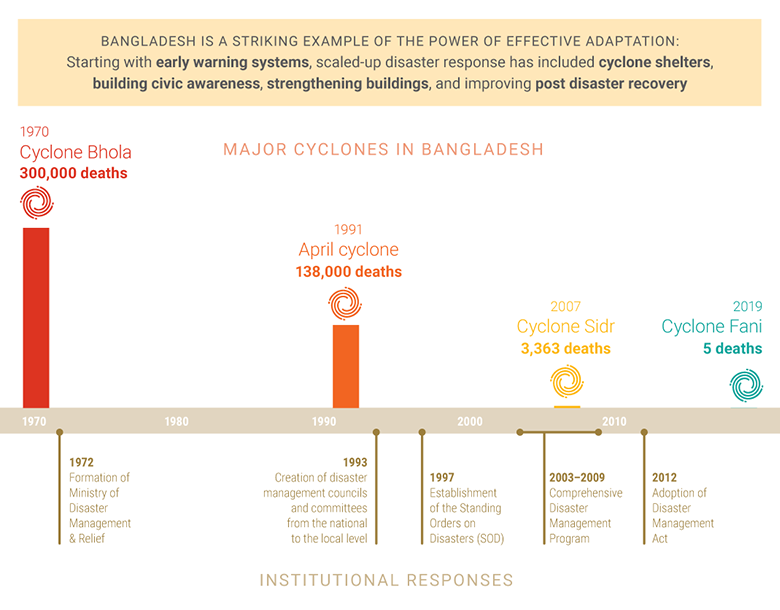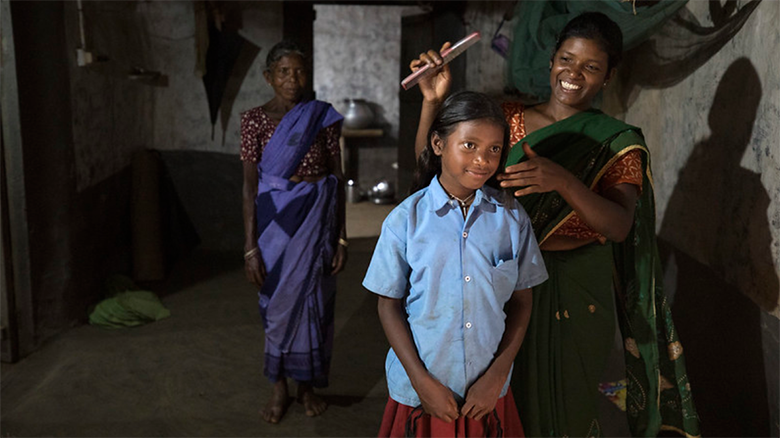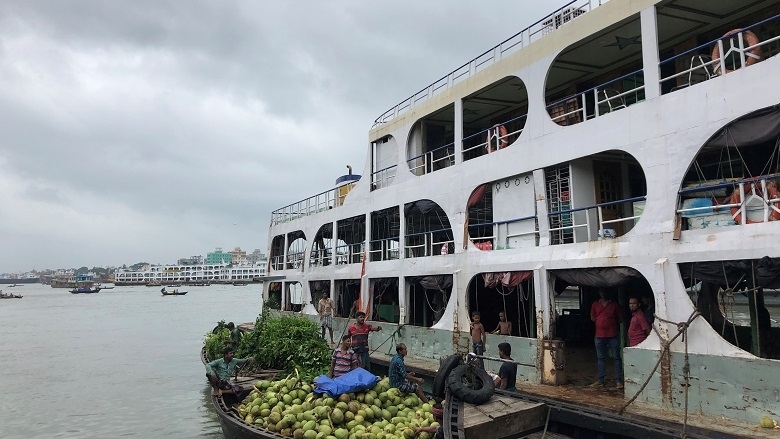Video prepared by the Haiti Civil Protection Department as part of an extensive public communications campaign during this year’s hurricane season.
3. Protecting the vulnerable from climate shocks
“There is no doubt that the disruption caused by COVID-19 reinforces the importance of guarding against the environmental risks that have severe and systematic impacts across the economy, and that it provides an opportunity to reconsider what's most important for the quality of life,” says Benoit Bosquet, World Bank Director for Sustainable Development in East Asia and Pacific.
Preparedness in India and Bangladesh, for instance, ensured that millions were moved to safety before Super Cyclone Amphan arrived on their coasts in May.
Key Policy Interventions in Bangladesh Contributed to Reduced Deaths from Climate Disaster. Photo: © Global Commission on Adaptation/World Resources Institute In the Pacific islands, Tuvalu and Vanuatu quickly accessed emergency funds through a new instrument known as a Catastrophe Deferred Drawdown Option after being hit by cyclones earlier this year.
“A lot of the systems that we put in place to deal with, more often than not, climate events, were also the same kind of emergency response systems that were quite helpful for governments in organizing and responding to the pandemic,” says Anna Wellenstein, World Bank Sustainable Development Director for Latin America and the Caribbean.
These systems include “adaptive social protection”, or safety nets that can quickly expand in the event of a major shock, such as a cyclone or drought. In Mozambique, for example, an existing safety net expanded to cover 115,000 additional households affected by Cyclones Idai and Kenneth in 2019.
“These kinds of systems can be scaled up during crises and adjusted to meet new needs."
During the pandemic, countries with strong social protection systems have been able to ramp up support to their impacted populations faster and more effectively.
4. Encouraging the shift to low-carbon energy while expanding access
In one of India's most remote villages, Sarita Asur, a subsistence farmer, talked about the day she switched on the light for the first time: “It was a very happy moment. It changed my family’s life.” With the help of a small firm backed by the Bank’s private sector-focused arm, IFC, her home is now outfitted with three LED bulbs that receive power from an 8-kilowatt grid. Photo: © Dominic Chavez/IFC The Group prioritized investments in renewable energy and energy efficiency as key to helping clients reduce emissions. It backed some of the world’s biggest solar projects, joining the Climate Investment Funds to support the Noor concentrated solar plant in Morocco, one of the few in the world to use this pioneering technology to store solar energy. The Group also supported the BenBan solar park in Egypt, and the Ultra Mega Solar Park in India, which helps power the Delhi Metro roughly 800 km away.
“It’s critical to start understanding climate as an opportunity,” says IFC Director of Climate Business Alzbeta Klein. “We know from evidence and from past work that a lot of renewable technologies are providing a fair number of jobs. In the recovery from the pandemic, countries have an opportunity to support the jobs that need to be created for the lower carbon pathways of the future.”
Off-grid solar has reached millions of people, mainly in South Asia and Africa, and may become the main way 40% of Africans gain access to energy, says Riccardo Puliti, the World Bank’s Senior Director of Infrastructure in Sub-Saharan Africa.
The Group’s Lighting Global program has built an international off-grid market which now supports a $1 billion-a- year industry providing energy access to over 150 million people.
“We target a doubling of energy access across Africa by the end of this next decade to keep Africa as the world’s climate-friendly continent. Over the last four years, our projects have been bringing on stream about 1,000 MW of new green, climate-friendly power, through geo-thermal, solar, and hydro—and there is more to come” says Thomas O’Brien, Senior Advisor in the context of the Group’s Next Generation Africa Climate Business Plan.
5. Shifting to lower-carbon transportation
Bangladesh has developed a low-carbon strategy and business plan for its inland waterway transport sector, with support from the Bank’s NDC Support Facility. Photo: © Mehrin Mahbub/World Bank With transport responsible for a quarter of energy-related greenhouse gas emissions globally, the Bank is supporting clients invest in public transit systems, shifting freight from roads to railways and, where possible, to waterways, which have the lowest emissions per ton kilometer of transport.
The Bank is backing a rail corridor dedicated to moving freight between the Indian megacities of Delhi and Kolkata and is looking to support inland waterways for moving freight and people across Bangladesh, India and Nepal, according to Guangzhe Chen, the World Bank’s South Asia Infrastructure Director.
, according to Franz R. Drees-Gross, World Bank Infrastructure Director for the region.
, according to Lucio Monari, the World Bank Infrastructure Director for the region.
“In order to effect a transition which is going to be successful we will have to find ways of mitigating the impact on people who work in the coal economy,” says Ranjit Lamech, Infrastructure Director for the World Bank’s East Asia and Pacific Region.
These kinds of policies can also complement carbon pricing tools: as of 2020, 61 countries in the world have or are scheduled to implement efforts that will price carbon.




